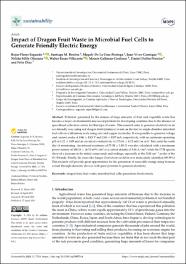“Impact of Dragon Fruit Waste in Microbial Fuel Cells to Generate Friendly Electric Energy“

View/
Download
(application/pdf: 1.576Mb)
(application/pdf: 1.576Mb)
Date
2023-04-27Author(s)
Rojas-Flores, Segundo
Santiago M., Benites
De La Cruz-Noriega, Magaly
Vives-Garnique, Juan
Milly Otiniano, Nélida
Rojas-Villacorta, Walter
Gallozzo-Cardenas, Moisés
Delfín-Narciso, Daniel
Díaz, Félix
Metadata
Show full item recordAbstract
“Abstract: Pollution generated by the misuse of large amounts of fruit and vegetable waste has
become a major environmental and social problem for developing countries due to the absence of
specialized collection centers for this type of waste. This research aims to generate electricity in an
eco-friendly way using red dragon fruit (pitahaya) waste as the fuel in single-chamber microbial
fuel cells on a laboratory scale using zinc and copper electrodes. It was possible to generate voltage
and current peaks of 0.46 ± 0.03 V and 2.86 ± 0.07 mA, respectively, with an optimum operating
pH of 4.22 ± 0.09 and an electrical conductivity of 175.86 ± 4.72 mS/cm at 8 ◦Brix until the tenth
day of monitoring. An internal resistance of 75.58 ± 5.89 Ω was also calculated with a maximum
power density of 304.33 ± 16.51 mW/cm2 at a current density of 5.06 A/cm2
, while the FTIR spectra
showed a decrease in the initial compounds and endings, especially at the 3331 cm−1 peaks of the
O–H bonds. Finally, the yeast-like fungus Geotrichum candidum was molecularly identified (99.59%).
This research will provide great opportunities for the generation of renewable energy using biomass
as fuel through electronic devices with great potential to generate electricity.“
Collections
- SCOPUS [380]

